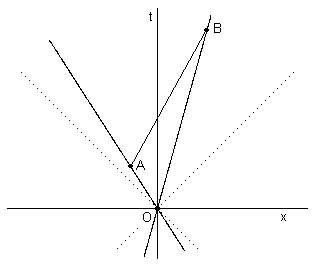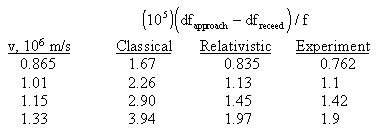

![]()
![]()
![]()
(c0/c)(tB - tA) = xB - xA
(c0/c)(tB - tA) = (u/c) tB + (v/c) tA



![]()
![]()
![]()
![]()
![]()
![]()



![]()
![]()
![]()
![]()

| 2.4 Doppler Shift for Sound and Light | |
| For historical reasons, some older text books present two different versions of the Doppler shift equations, one for accoustic phenomena based on traditional Newtonian kinematics, and another for optical and electromagnetic phenomena based on relativistic kinematics. This sometimes gives the impression that relativity requires us to apply a different set of kinematical rules to the propagation of sound than to the propagation of light, but of course that is not the case. The kinematics of relativity apply uniformly to the propagation of all kinds of signals, provided we give the exact formulae. The traditional accoustic formulas are inexact, tacitly based on Newtonian approximations, but when they are expressed exactly we find that they are perfectly consistent with the relativistic formulas. | |
| Consider a frame of reference in which the medium of signal propagation is assumed to be at rest, and suppose a transmitter ("out") and receiver ("in") are located on the x axis, with the transmitter moving to the left at a speed of v and the receiver moving to the right at a speed of u. Let c0 denote the speed at which the signal propagates with respect to the medium. Then, according to the classical (non-relativistic) treatment, the Doppler frequency shift is | |
|
(1) |
| (It's assumed here that u and v are less than c0, because otherwise there may be shock waves and/or lack of communication between transmitter and receiver, in which case the Doppler effect does not apply.) The above formula is often quoted as the Doppler effect for sound, and then another formula is given for light, which may create the impression that relativity arbitrarily treats sound and light signals differently. In truth, relativity has just a single formula for the (one-dimensional) Doppler shift, which applies equally to both sound and light. This formula can basically be read directly off the spacetime diagram shown below | |
|
|
| If a transmitter on worldline OA turns a signal ON at event O and OFF at event A, so the proper duration of the signal is the magnitude of OA, and if the signal propagates with the speed of the worldline AB, then the proper duration of the pulse for a receiver on OB will equal the magnitude of OB. Thus we have | |
|
(2) |
| and | |
|
(3) |
|
(4) |
| The equation for c0/c can be re-written in the form | |
(c0/c)(tB - tA) = xB - xA |
(5) |
| so we can substitute for the right hand terms from the expressions for v/c and u/c to give | |
(c0/c)(tB - tA) = (u/c) tB + (v/c) tA |
(6) |
| from which we get | |
|
(7) |
| Substituting this into the ratio of |OA| / |OB| gives the ratio of proper times for the signal, which is the inverse of the ratio of frequencies: | |
|
(8) |
| Now, if u and v are both small compared to c, it's clear that the relativistic correction factor (the square root quantity) will be indistinguishable from unity, and we can simply use the leading factor, which is the classical Doppler formula for both sound and light. However, if u and/or v are fairly large (i.e., on the same order as c) we can't neglect the relativistic correction. | |
| It may seem surprising that the formula for sound waves in a fixed medium with absolute speeds for the source and observer is also applicable to light, but notice that as the signal propagation speed c0 goes to c, the above Doppler formula smoothly evolves into | |
|
(9) |
| which is very nice, because we immediately recognize the quantity inside the square root as the multiplicative form of the relativistic composition law for velocities. In other words, letting w denote the composition of the speeds u and v given by the formula | |
|
(10) |
| it follows that | |
|
(11) |
| Consequently, as c0 increases to c, the absolute speeds v and u of the source and observer relative to the fixed medium merge into a single relative speed w between the source and observer, independent of any reference to a fixed medium, and we arrive at the relativistic Doppler formula for waves propagating at c for a source and observer with a relative velocity of w: | |
|
(12) |
| All the above was based on the assumption that the transmitter and receiver are moving relative to each other directly along their "line of sight". More generally, we can give the Doppler shift for the case when the motions of the transmitter and receiver are at any specified angles relative to the "line of sight", although we must be careful when specifying the angles, because of the effect of aberration. As Einstein explained in 1905, we need only consider the case of an observer moving with velocity v (with units chosen so that c=1) relative to an infinitely distant source of light of frequency n, in such a way that the line of sight from the source to the observer makes the angle f with the observer's velocity as evaluated from the source's frame of reference, the frequency n' of the light impinging on the observer will be | |
|
(13) |
| Obviously if f = 0 this reduces to the previous. We emphasized that the angle f is evaluated from the source's frame of reference because the same angle generally has a different value when referred to the observer's frame, and this sometimes causes confusion. If, as Einstein did, we define the angle in terms of the source's frame, then we arrive at the above formula, but if we define the angle f in terms of the receiver's coordinates, we get a different formula. The difference between the two versions of f is due to aberration. If we let f ' denote the angle between the observer's velocity vector and the incoming ray with respect to the observer's own frame of reference, then f ' is related to f by the aberration equation | |
|
(14) |
| (See Section 2.5 for a derivation of this equation.) Making this substitution into Einstein's formula gives | |
|
(15) |
| Interestingly, this shows that for the two "linear" cases, when f or f ' are zero, we have | |
|
(16) |
| respectively. This again highlights the peculiar symmetry between source and observer. | |
| Returning to the purely one-dimensional case, it's interesting to examine the form of the classical and relativistic Doppler shift equations, to clarify precisely how they differ. Recall that for a classical treatment of a wave with characteristic speed c in a material medium the Doppler frequency shift depends on whether the source or the receiver is moving relative to the fixed medium. If the receiver is stationary and the source is receding at a speed of v (normalized so c = 1), then the frequency shift is given by | |
|
(17) |
| whereas if the source is stationary and the receiver is receding the frequency shift is | |
|
(18) |
| To the first order these are the same, but they obviously differ significantly if v is close to 1. In contrast, the relativistic Doppler shift for light does not distinguish between source and receiver motion, but simply predicts a frequency shift equal to the geometric mean of the two classical formulas, i.e., | |
|
(19) |
| Naturally to first order this is the same as the classical Doppler formulas, but it differs from both of them in the second order, so we should be able to check for this difference, provided we can arrange for sources and/or receivers to be moving with significant speeds. The Doppler effect has in fact been tested at speeds high enough to distinguish between these two formulas. One of the earliest such tests was performed by Ives and Stilwell in 1938. They shot hydrogen atoms down a tube, with velocities (relative to the lab) ranging from about 0.8 to 1.3 times 106 m/sec. As the hydrogen atoms were in flight they emitted light in all directions. Looking into the end of the tube (with the atoms coming toward them), Ives and Stilwell measured a prominent characteristic spectral line in the light coming forward from the hydrogen. This characteristic frequency f was Doppler shifted toward the blue by some amount dfapproach because the source was approaching them. They also placed a mirror at the opposite end of the tube, behind the hydrogen atoms, so they could look at the same light from behind, i.e., as the source was effectively moving away from them, redshifted by some amount dfreceed. | |
| The following is a table of results from the original 1938 experiment for four different velocities of the hydrogen atom: | |
|
|
| Incidentally, Ives and Stillwell themselves were not advocates of relativity, and in fact gave a completely different theoretical model to account for their experimental results and the deviation from the classical prediction. This illustrates the fact that the results of an experiment can never uniquely identify the explanation. They can only split the range of available models into two groups, those that are consistent with the results and those that aren't. In this case it's clear that any model yielding the classical prediction is ruled out, while the Lorentz/Einstein model has survived nicely. | |
| Return to Table of Contents | |